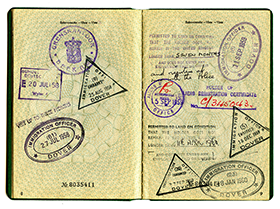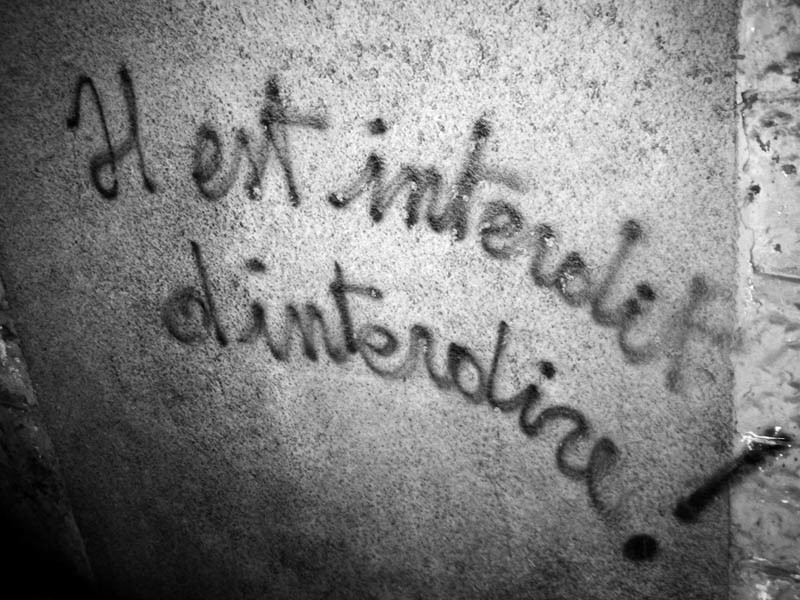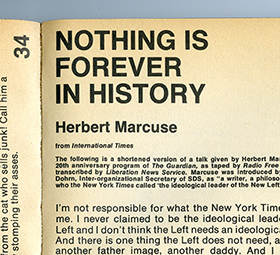1960s
Text by Jochen Gerz

When does he hear the word “liberation” for the first time? What are his words for new before he knows the word “new”? Maybe in 1961. The Stone Age of the fifties slowly unravels, but he remembers only much later that the fifties were a Stone Age.

Europe? Where else do you want me to show this work? (Barnett Newman). Years later, John Gibson says the same thing at the first Art Basel Fair. For him, Basel is the first stop to Europe: Allen Kaprow’s car tyres are on view simultaneously at Handschin’s gallery (Fluxus is part of the DNA) and at Beyeler Giacometti. The war is finally over (or has never taken place). Gratitude for just being around. In the good old alpha-world of painting and the smell of turpentine, he wants to be a groupie (he wants to continue hiding his writing). A few words a day and listening to what others have to say, that’s the programme. Normality. Vero: If you were still writing three words a day, we would still be together.

There is never a clear-cut decision about what to do, or a choice made between literature and art.
He just likes to do what he does and at the same time he is becoming aware somehow that all he does is changing constantly. Art is much more hands-on, doable, affordable (later they would say performative) – that is, what a few people call art at the time, among them a handful who are migrating from literature to art. This is not painting. This does not need to be painting. He just wants to go on writing and keep moving, jumping boundaries, and that is what he does. The Renaissance is one bus stop away, there are others before and others to come. Looking forward is in this respect like looking back. He has not stopped doing this since.

When he asks people, invites them to speak and write in his work, when he reduces his role to that of a scribe, an empty surface or a single question, he considers himself to be writing.
He wants to take writing to another place. This place is quite hospitable. Some people have a problem with the wall being swamped with words and art invaded by time. They know what it means to visit an exhibition. They know what it means to go to the movies. Statistics show that viewers spend less and less time in front of artworks … like video and performance, words introduce time-bound reception and perception into visual art. As you read what you see, you also see what you are missing. Seeing is measured in time. Because of the shared context of time, new media and the new spaces for art, there is a connection between writing, seeing, reading, process and multiplication, which is different from what was experienced before. What he knew before was called writing, not art. Both were caught up in resemblance, both were knocking at the door of real life (once more).


The news is nothing new, but it is the only news. The news is a message, but it comes at the wrong time – not at school, not at university, not at the museum, and not in his own life. 60 years before, too late. Once at the wrong time, always at the wrong time. It is the only news. The beginning of the 20th century like a lifeline. I have seen people, with my own eyes. Contemporaries. The secret league of ignorance: Zamyatin, Yesenin, Tatlin, Gorky: the revolutionaries, the authorities, the competences. He read it wrong: once an autodidact, always an autodidact. Futurists, the migrants in London and Berlin. Where is Paris? (And who thinks about museums? It is the naked people, stupid). And always and again the Jews, the small and the large societies of the scattered: I have seen people. Daddy, when did the present die?

Second attempt, 1968: student movement and social upheaval, politicisation, radicalisation, denouncing of time-honoured social and cultural rituals, criticism of the “unlived” life, criticism of consumerism, of objects, criticism of education.

Cooperative childcare, manifestations of social creativity (experiments, manifestos, theory, leaflets, posters, stickers, Mail Art, protests, participation, street events...) and at the same time a growing convergence between art forms (music, art, litterature) and between many other occupations and activities. People’s actual practice becomes the focal point. Finding common ground and developing each individual’s potential for solidarity take precedence. Deeds and actions turn creative in cooperation with others. Contacts with the alternative experimental scene in many countries. Exhibitions, festivals and manifestations at universities as a result of contacts with other artists by post, and collaboration between local groups and initiatives on all continents.

It is possible. Not a single step without Bill Shankly. You will never walk alone (as long as he is alone). Retreat, too, the thousand beaten paths of denial – retreat into painting, retreat into private life, retreat into a bohemian existence, into the privileges of one’s upbringing, retreat into inner emigration, the return of solitude – old hat. What to do? What remains to be done? Here lying before you is the most beautiful landscape between heaven and earth: the people, the naked societies are those who remain, those left behind by modernity – the human, frozen in mid-leap, is the sculpture we are proud of. The countless authors of the movement – all of them transcend the format of the small elitist cultural cabinets. A level playing field. Much, much later, like a memory, the abrupt sentence of Peter Weibel: On the Internet there are no space problems. And still later Google: the right to be forgotten. The first day of the cosmos is a memory.

A visual diary about daily life and art, about the gift of change, about the billion talents of everybody: Situationism, Summerhill and Bettelheim. When did you hear the word love for the first time? About himself, about France and its jolis walls, about France and its hidden pasts. Safe return, safe memories – about himself and about the new world of institutions, entrism (another quote). Creating pictures for a safe place. Once you start making pictures, you know their destination. One step at a time (circle the Holy Grail). To join the doubt and irreverence establishment after 1968. The Civil Society for the Studies of Everyday Life – to leave the street for “rural life”, to become controversial and contradictory.

Turn your life into art. Swap your life for a double life. If he finds another life, he will leave art behind. He does not want to sell his life. Art answers: Leaving me is art. How to reboot, how to question yourself? Midas is an autodidact with the touch. Can he explain what he is doing (where do you belong, I mean to what art movement)? He says that he keeps running away from you. He has a question for everything. He can make an artwork a day. And you say: Can we make an exhibition?

Invitation to teach at an art school in Mexico City (Bellas Artes). Learning by teaching, as he has no art school experience himself. When he arrives the students are on strike, people are shot, the university is closed for the month of his stay. He sees a sticker on a tree, cannot read it but remembers the size. He could paste and hide it with one hand. He now understands Paris better (last year), the non-violence of May 1968, the playfulness, the theatrics. The days that made the old quotes jealous. His relief and gratitude for being in Paris after the life he did not live, as a child, for being one of many people – for being able to understand what was going on, for participating. France-Soir: One death at Flims. The posters in Paris were bigger than those in Mexico (which were the same size as his sticker in Florence).

What is art for “normal people”? Who for him is a worker? Asking people questions, is this art? Does he care for people? Do they care for art? What do people have in common? Does he care for them because they work in a factory? “Art is not working in a factory” (Ken Lum, 1983). They like their children to play an instrument or learn how to dance. Can there be common ground? Is communication common ground? Standing in front of people eating in Hoffmann-La Roche’s corporate cantina, asking questions during lunch. Moving from table to table. Collecting the papers left behind with the answers. Some are on the floor, a few are in the garbage. It is possible. To be alone again. Will they visit the exhibition? Some of them do.